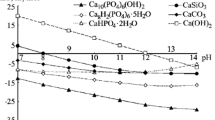Summary
By means of X-ray powder diffraction (XRD), octacalcium phosphate (OCP, Ca8H2(PO4)6·5H2O, Ca/P=1.33) has been shown to be a metastable precursor of hydroxyapatite (HA, Ca10(PO4)6(OH)2, Ca/P=1.67) duringde novo HA formation in aqueous solutions containing [CaCl2]=1.0–2.0 mM and [Na2HPO4]≤3 mM, kept at 37°C, 300 mosM and stirred gently at 150 rpm. At the precipitation boundary with initial pH=7.4, OCP is stable for at least 24 hours when [Ca]=1.0 mM, and is less stable when [Ca]=2.0 mM, transforming into a mixture of OCP and HA within 24 hours. Almost complete transformation to HA within 24 hours takes place with high [Ca] and high [Pi]. Statistical analysis of the pH 7.4 precipitation boundary data supports the XRD findings: although [Ca][Pi] values vary significantly (P<0.001) with [Ca] (2.70±0.05 mM2 for [Ca]=1.0 mM and 2.00±0.10 mM2 for [Ca]=2.0 mM), [Ca]1.33[Pi] values do not vary with [Ca] suggesting that the initial precipitation process is 6(1.33 Ca+Pi)→OCP. With initial pH=7.6, a different precipitation boundary with lower [Ca][Pi] values has been determined. These findings strongly support the fact that rat epiphyseal cartilage fluid which has [CaUF][PiUF]=2.6 mM2 (UF=ultrafiltrate) and pH 7.6 [2] should be able to supportde novo calcification.
Similar content being viewed by others
References
Neuman WF, Neuman MW (1968) The chemical dynamics of bone mineral. Chicago University Press, Chicago
Howell DS, Pita JC, Marquez JF, Madruga JE (1968) Partition of calcium, phosphate, and protein in the fluid phase aspirated by calcifying sites in epiphyseal cartilage. J Clin Invest 47:1121–1132
Boskey AL, Posner AS (1976) Formation of hydroxyapatite at low supersaturation. J Phys Chem 80:40–45
Brown WE, Smith JP, Lehr JR, Frazier AW (1962) Crystallographic and chemical relations between octacalcium phosphate and hydroxyapatite. Nature 196:1048–1055
Cheng P-T (1985) Octacalcium phosphate formation in vitro: implications for bone formation. Calcif Tissue Int 37:91–94
Furedi-Milhofer H, Oljica-Zabcic E, Purgaric B, Kosar-Grasic B, Pavkovic N (1975) Precipitation of calcium phosphates from electrolyte solutions. IV. Precipitation diagrams of the system calcium chloride-sodium phosphate—0.15 M sodium chloride. J Inorg Nucl Chem 37:2047–2051
Walton AG (1979) The formation and properties of precipitates. Robert E. Krieger, Huntington, New York, p 76
Cheng P-T, Pritzker KPH (1983) Solution Ca/P ratio affects calcium phosphate crystal phases. Calcif Tissue Int 35:596–601
Brown WE, Schroeder LRW, Ferris JS (1979) Interlayering of crystalline octacalcium phosphate and hydroxyapatite. J Phys Chem 83:1385–1388
LeGeros RZ (1976) Variations in the crystalline components of human dental calculus: I. Crystallographic and spectroscopic methods of analysis. J Dent Res 53:45–50
LeGeros RZ, Kijkowska R, LeGeros JP (1984) Formation and transformation of octacalcium phosphate, OCP: a preliminary report. Scan Elec Mic IV:1771–1777
Eanes ED, Gillessen IH, Posner AS (1965) Intermediate states in the precipitation of hydroxyapatite. Nature 208:365–367
Eanes ED, Meyer JL (1977) The maturation of crystalline calcium phosphates in aqueous solution at physiologic pH. Calcif Tissue Res 23:259–269
Francis MD, Webb NC (1971) Hydroxyapatite formation from a hydrated calcium monohydrogen phosphate precursor. Calcif Tissue Res 6:335–342
Cheng P-T, Pritzker KPH (1983) Pyrophosphate, phosphate ion interaction: effects on calcium pyrophosphate and hydroxyapatite crystal formation in aqueous solutions. J Rheumatol 10:769–777
Meyer JL (1984) Can biological calcification occur in the presence of pyrophosphate? Arch Biochem Biophys 231:1–8
Hunter GK, Allen BL, Grynpas MD, Cheng P-T (1985) Inhibition of hydroxyapatite formation in collagen gels by chondroitin sulphate. Biochem J 228:463–469
Author information
Authors and Affiliations
Rights and permissions
About this article
Cite this article
Cheng, PT. Formation of octacalcium phosphate and subsequent transformation to hydroxyapatite at low supersaturation: A model for cartilage calcification. Calcif Tissue Int 40, 339–343 (1987). https://doi.org/10.1007/BF02556696
Received:
Revised:
Issue Date:
DOI: https://doi.org/10.1007/BF02556696




